June Birth Month Symbols And Fun Facts
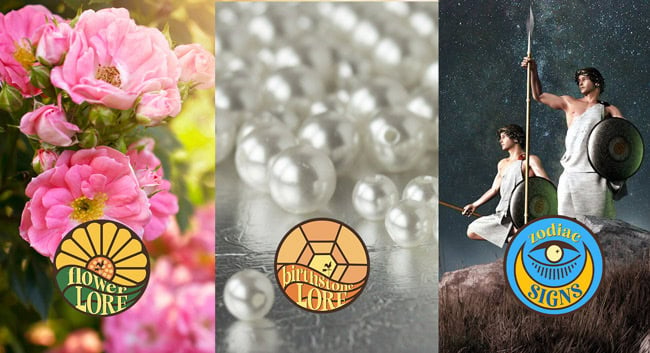
Welcome June! This month is all about peace and love. Between the resurgence of happiness in May and the strength that resonates in July, June is a month of balance. For those in the Northern hemisphere, it means the start of summer and warmer weather. Farmers’ Almanac invites you to discover delightful June birth month symbols: flowers, stones, zodiac signs, herbs, bird of the month, and more! We hope these, along with the June fun facts will help you usher in the beauty of a new season. Share your thoughts (and photos) in the comments, and let’s cherish this month of peace together.
June Birth Month Symbols
June is filled with symbols that remind us of sweet affection and stillness. The June birth flower rose symbolizes love, while the June birthstone pearl stands for purity, bringing us peace and balance in life. Gemini and Cancer stand as the month’s zodiac keepers, bringing intellect and protection to those born during this month. The dove, June’s bird of the month, coos with delicate tranquility. Lavender and this month’s healing herbs are associated with serenity, adding even more meaning for those born in this month.
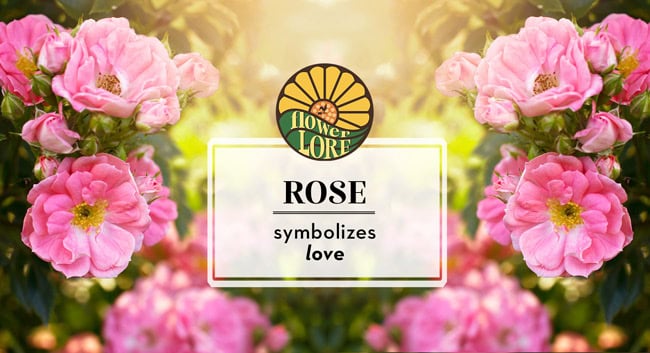
June Birth Month Flower: Rose
One of the most recognizable and loved flowers, roses reach their peak during the month of June. These iconic blooms are prized for their stunning beauty, vibrant colors, and sweet fragrance, dubbing them “Queen of Flowers.” The rose family (rosaceae) is made up of around 150 species of perennial flowering shrubs around the globe, from garden classics to exotic climbers, with most species being native to Asia. The cultivation of garden roses dates back 5,000 years to China.
Any questions? Contact [email protected]
June’s birth flower is often given as a sign of affection. These woody perennials come in many different colors, with each hue representing a different type of love. Learn more about the rose.
June Fun Facts:
- Fossil evidence suggests that rose family plants date back 35 million years.
- The rose became the official floral emblem of the United States in 1986. The Whitehouse itself boasts a rose garden which dates back to John Adam’s presidency, with an official launch of the Rose Garden by Woodrow Wilson’s wife, Ellen Wilson.
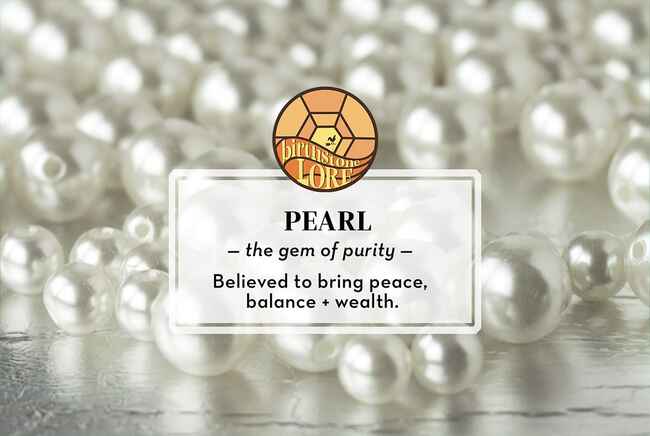
June Birthstone: Pearl
The pearl has been a timeless, simple, yet elegant wardrobe staple for centuries. They are the only gem found within living creatures, both salt and freshwater mollusks (oysters or mussels). Pearls are formed when the mollusk secretes a substance called nacre around an irritant that gets lodged in their shells, such as a piece of sand or invading parasite. However, extensive pearl fishing has exterminated most of the natural pearl beds, so the vast majority of pearls today are cultured. Cultured or farmed pearls get a little help from humans who inject a piece of mantle tissue or round bead into a host mollusk which then gets covered with layers of nacre, just like a natural pearl.
Pearls are the gem of purity and are believed to bring peace, balance, and wealth, making them the perfect birthstone for the June. Learn more about the pearl and alternative June birthstones.
Related product: June Birthstone – Moonstone Necklace
June Fun Facts:
- Pearl Harbor was called Wai Momi (“Pearl Waters”) by the Hawaiians because of the pearl oysters that once grew there.
- Pearls are soft and sensitive to extreme heat and acidity. They should be kept away from acids such as perfume and hairspray.
June Colors: White And Pale Orange
June’s color theme is white and pale orange, ideal hues for the start of summer.
White is tied to the month’s birthstone, the pearl. White is often associated with purity and innocence, and the puffy clouds of summer. Pale orange evokes a feeling of possibility and playfulness, a perfect combination for the cheery, warm days of June.
June Fun Facts:
- The word “orange” comes from the Sanskrit word “naranga,” which means “orange tree.”
- In many Western cultures the color white has long been associated with purity and virtue, which is one of the reasons why some brides choose to wear white.
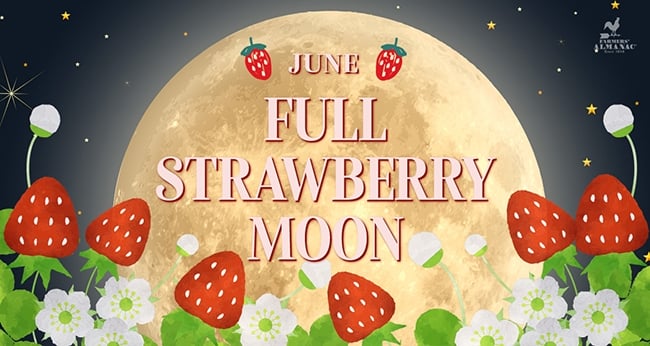
Full Strawberry Moon
June’s full Moon is known as “The Strawberry Moon,” a moniker given by the Algonquin tribe, marking the peak of ripening strawberries in the Northern Hemisphere. The Strawberry Moon is either the last full Moon of spring or the first of summer. Other nicknames are “Honey Moon” and “Mead Moon” paying homage to the time when honey is ready for harvest.
“Rose Moon” relates to the rose, June’s birth flower, which blooms during June. NASA also indicates that this name also potentially refers to June’s full Moon being positioned lower in the sky, closer to the horizon, in the Northern Hemisphere, giving it a “warmer” reddish glow. Learn more about the June full Moon.
June Fun Facts:
- The tradition of calling the first month of marriage the “honeymoon” can be traced back to the 1500s in Europe, when it was custom to marry in June.
- For Hindus, June’s full moon corresponds with Vat Purnima (meaning full Moon), which is the time when women celebrate their love for their husbands by fasting and tying a ceremonial knot around a Banyan tree.
Zodiac Signs: Gemini And Cancer
Two zodiac signs associated with the June birth month: Gemini and Cancer.
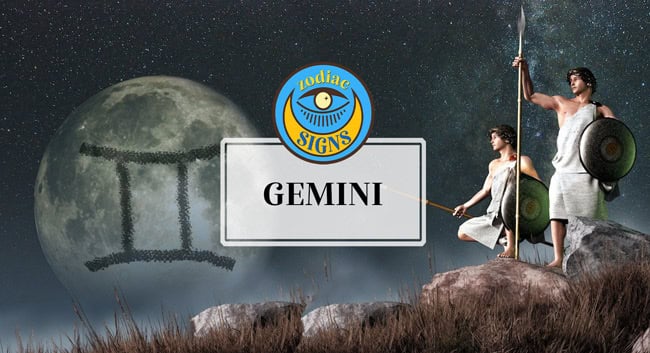
Gemini (May 21-June 20)
Represented by the celestial twins, Geminis are considered the most complex of the zodiac signs. Gemini’s sign suggests dual personality, with those born under this sign often labeled “Jack of all Trades.” Geminis are playful, smart, and sharp-witted. Known to be optimistic, Geminis can find the silver-lining and can adapt easily to many situations and setbacks. Geminis like to tap into their creativity and to challenge themselves intellectually.
Geminis can easily mingle in a variety of social situations and make great friends and loyal companions. They are funny, witty, and thrive on being the center of attention. The chatty and intellectual Gemini also has a sensitive side that needs tending, valuing love and simple acts. Their longing for stability ultimately drives a Gemini to settle down with a partner. Despite their gregarious nature, Geminis often hide behind a mask to guard their vulnerabilities and have difficulty expressing their true feelings.
Cancer (June 21-July 22)
Cancer, the fourth sign of the zodiac, is described as emotional, intuitive, and nurturing. Characterized by the crab, they are soft and vulnerable on the inside, often trying to hide their sensitivity behind a tough exterior. The most nurturing of the zodiac signs, Cancers are very perceptive when it comes to relationships, ideas, and motivations. The perceptive Cancer can often find solace from connecting with higher power and often seek some form of religion or spiritual practice.
As the emotional heart of the zodiac, Cancers are one of the most loyal of the zodiac, almost to a fault. They will go to any means to help someone they love and will stand up for their beliefs. Cancers may seem standoffish when you first meet them, but once they decide to open up, you will have a friend for life. Large social gatherings can be overwhelming for Cancers and they are not a fan of small talk. Even though Crabs can come off as intense or volatile, they also have a funny side, with a wry sense of humor, and are particularly adept at observing and reading their audience. Cancers are artistic and often require a creative outlet, reading, painting, or playing music.
June Fun Facts:
- Gemini is influenced by Mercury, the planet of communication and intellect. People born under this zodiac sign are believed to be energetic, sociable, free thinkers.
- Cancer is said to be ruled by the Moon, which is associated with emotions and instinct. Those born under this sign are considered to be highly attuned to their own feelings and the emotions of others. As a cardinal sign, Cancers are natural leaders with ambition and adaptability.

June Herbs of the Month
Herbs are thought to relate to specific zodiac signs. According to this belief, certain ones are especially beneficial and may bring special healing or help.
As such, certain herbs are thought to amplify the positive characteristics of individuals born under particular signs, or to offer remedies for the common challenges they face.
Gemini herbs (May-June): Thyme is a popular Mediterranean herb renowned for its dietary, medicinal, and ornamental uses. Belonging to the mint family, thyme boasts a unique flavor, making it essential in the kitchen. Thyme comes in dozens of varieties, with French and English being the most popular in the culinary world. Generally dried, thyme adds a savory touch to many dishes, such as soups, meats, and veggies. In the garden, you can grow thyme in containers or directly in the ground. This tough plant requires minimal water and flourishes in the summer heat. If left out to winter, new sprouts will emerge in early spring.
Beyond the kitchen, thyme has a rich history of medicinal properties and is packed with nutrients. It has been known to support the immune system, improve mood, treat respiratory issues, fight sore throats, addresses acne, and helps lower blood pressure and cholesterol. For centuries, thyme has symbolized courage and strength.
Cancer herbs (June-July): Lavender symbolizes calmness, relaxation, and tranquility making it an ideal herb for those born in June. A member of the mint family, lavender is a popular and fragrant perennial plant that adds aroma and beauty to any garden. With over 450 different varieties of lavender, English lavender, French lavender, and Spanish lavender are the most widely cultivated species.
Lavender has been cultivated for culinary, aesthetic, and medicinal uses for centuries. Lavender gets its name from the Latin verb lavare, meaning “to wash,” because of its use in baths to cleanse the body and spirit. Today lavender is commonly added to soaps and shampoos. It is also a common essential oil that when inhaled has calming properties that can reduce anxiety and aid in sleep. In ancient times, lavender flowers were commonly sewn into sachets to help the sleepless.
Lavender blooms from early spring to late summer, loving ample sun and proper drainage. It is commonly planted along pathways or around seating areas in gardens and makes an excellent companion plant for almost anything. Growing lavender attracts beneficial pollinators, such as bees and butterflies and deters unwanted pests such as deer, rabbits, and mosquitos. Please note: Lavender contains a small amount of linalool, which is toxic to dogs and cats.
June Fun Facts:
- Thyme can be used as a pest control for rats, mice, and mosquitos. Make your own homemade repellent by mixing four drops of thyme oil for every teaspoon of carrier oil, such as olive oil, jojoba oil, etc. (or every two ounces of water).
- Strip off lavender buds from stems and tuck them into little cloth bags to make your own lavender satchels. Place them in your dresser drawers or under your pillow for a relaxing, calming scent.
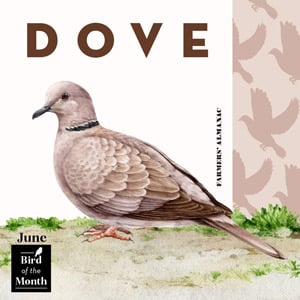
June Birth Month Bird: Dove
The dove is the universal symbol of peace and harmony. As such, the dove is the ideal bird month for people born in June who are known to have a peaceful, sociable demeanor. Beyond peace, the dove’s soft and gentle presence epitomizes love. For centuries they have carried a strong historical connection with the divine realm and intuition.
Known for their distinct “coo,” doves are the smaller members of a diverse group of birds in the Columbidae family. These strong flyers have incredible navigation abilities are deemed the GPS of the bird kingdom. Like those born in June, the dove is also extremely adaptable and have found ways to adapt to almost every environment around the globe, including urban settings, rainforest, and even swamps.
June Fun Facts:
- There are over 340 species in the Columbidae family, made up of doves and pigeons, differentiated only by size. Birds referred to as doves are typically smaller than pigeons.
- Doves are one of the few birds that drink by sucking their water up versus taking a bill-full and letting it trickle down their throats. They can drink their entire day’s worth of water in 20 seconds!
What Does “June” Mean?
The month of June is named from Junius, Latin for Juno, the Roman goddess of marriage and childbirth. Wife of Jupiter, this powerful ruler was known as a protector of women and children, and deemed a forceful guardian for those in need. In Latin, the month was spelled “Iunius” meaning “related to Juno.” (Juno was spelled “Iuno” then.) In the 1600s, the French changed all Latin words spelled with an initial “I” (like the month “Iunius”) to an initial “J.”
June Fun Facts:
- June is also thought to be inspired from the Latin “juvenis,” meaning “young people.”
- The Anglo-Saxons referred to June as June and July as Liða, an Old English word meaning “mild” or “gentle,” which referred to the period of warm, seasonable weather either side of Midsummer. To differentiate between the two, June was sometimes known as Ærraliða, or “before-mild,” and July was Æfteraliða, or “after-mild.”
What Is Midsummer?
Midsummer is a holiday traditionally celebrated on June 24. Why is it called Midsummer, even though it falls shortly behind the actually start of summer (solstice)? Historically, Midsummer marks the halfway point of the growing season, between planting and harvest. Celebrated in many countries, it is a national holiday in Sweden and Finland.
Originally a pagan celebration to welcome summer and to bring good fortune to the harvest, Midsummer festivities include dancing, singing, lighting of a bonfire, and picking flowers. As Christianity spread, Midsummer also became associated with the Feast Day of Saint John, on June 24.
Related: When And What Is Midsummer?
June Fun Facts:
- Juneteenth is a federal holiday in the United States on June 19. The name comes from the date: June nineteenth became June-teenth. On June 19, 1865, all remaining slaves in Texas were freed by Union soldiers. The day is also known as Emancipation Day and celebrates freedom and equal rights.
- Father’s Day is celebrated around the world on different dates. In Canada, the United Kingdom, and the United States, it falls on the third Sunday of June.
Any questions? Contact [email protected]
June Weather Lore
Before the invention of modern meteorology, people would have to look to the sky for their forecast. Farmers and sailors in particular would rely on weather lore to predict the weather. You may be familiar with common lore such as “Red sky at night, sailor’s delight. Red sky in the morning, sailor’s warning.” This is an ancient rhyme that has existed across cultures for thousands of years and was first recorded in the Gospel of Matthew. In Matthew 16:2b–3, Jesus says: “When it is evening, you say, ‘It will be fair weather; for the sky is red.’ And in the morning, ‘It will be stormy today, for the sky is red and threatening.’ Over time it was turned into a rhyme as an easy way to help people predict the weather.
There may be some meteorological truth behind the idea, based on the cloud cover and light refraction. A red sky appears when dust and small particles are trapped in the atmosphere by high pressure. If the morning skies are of an orange-red glow, it signifies a high-pressure air mass has passed, making way for an unstable low-pressure system. Conversely, a red sky at sunset means high pressure, or pleasant weather, is moving in from the west, so therefore the next day will usually be dry and pleasant.
Some other lesser-known weather lore expressions that originated by connecting nature to patterns in weather are:
- If June be sunny, harvest comes early.
- June, damp and warm, does the farmer no harm.
- In June, when there is no dew, it indicates rain.
- A good rain in June sets all in tune.
Speaking of weather … Plan ahead with Farmers’ Almanac Summer Forecast
June Night Sky
One of the best constellations to see in June is Ursa Minor, or “the little bear.” It is easily recognized because it contains the famous Little Dipper asterism. The Little Dipper is considered an asterism, a group of stars that form a pattern in the night sky, and not a formal constellation. Ursa Minor contains Polaris, the North Star, which is located at the end of the dipper’s handle. The North Star is used as a navigational tool as it marks due north.
The Summer Triangle is visible throughout the year, but it is most prominent in June and July. The Summer Triangle is an asterism, not a constellation, made up of three bright stars in three different constellations: Vega, Deneb, and Altair. As the sky darkens on a warm June night, look eastward for Vega, the brightest star in the eastern sky to spot this huge triangle.
Summer Solstice
The summer solstice in June marks the start of astronomical summer in the Northern Hemisphere and the longest day of the year. It occurs when one of Earth’s poles is tilted toward the sun at its most extreme angle, and due to Earth’s tilt, this happens twice a year, once in the Northern Hemisphere and once in the Southern Hemisphere.
At the June solstice, which happens on either June 20 or 21, the sun rises and sets farthest north on your horizon, and the sun will be directly overhead at noon and marks the longest days and shortest nights. After this solstice, the sun will begin moving southward in our sky again.
June Fun Facts:
- Ancient cultures recognized the Sun’s path across the sky, the length of day, and sunrise and sunset location changed throughout the day. Monuments such as the ones at Stonehenge in England and at Machu Picchu in Peru were built to follow the sun’s yearly progress.
- Unlike other stars, which appear to move across the sky, Polaris, the North Star, remains almost stationary, making it a favored navigational guide for centuries. It has been a helpful tool for sailors in determining latitude and locating due North.
June Gardening
Warmer temperatures and the extra sunlight make June an affable month for people and plants alike. By now the threat of frost has passed, making June a busy month for gardeners. Here are some tasks to add to garden to-do list this month to ensure that your gardens are thriving by midsummer:
- Deadhead any spring blooms after they have finished blooming to help them conserve energy.
- Add a layer of mulch to help plants retain moisture as the temperatures heat up.
- Prune or thin out any perennials to prevent them from taking over neighboring plants.
- Move self-sown flowers and perennials outside.
- Side dress plants with mature compost or aged manure.
- Be on alert for pests and disease such as Japanese beetles, aphids, snails, slugs, mildew, etc.
- Also keep an eye out for rabbits and groundhogs and catch them before they get to your harvest.
- Cover ripening berries with netting to keep birds off.
- Plant beans, squash, melons, gourds, and cucumbers. Add any trellises needed for growing vines.
- Direct sow annual seeds outside.
- Pick ripe strawberries.
- Keep your vegetable garden moist and water transplants daily until well established.
- Thin seedlings to proper spacing as they come in.
- Stop harvesting asparagus as the stalks become thin.
- Stake or cage your tomato plants.
- Mulch your vegetable gardens with straw to retain moisture.
- Keep on top of weeding, to prevent your plants from fighting for precious water and nutrients.
June Trivia
- The baby name June, meaning “young,” became popular in the US in the early twentieth century. By 1925, it was the 39th most popular girl’s name.
- Keeping in line with its namesake, June kicks off the modern-day wedding season, which correlates with childbirth. June was considered the midsummer month in ancient times, making it an ideal month to marry in. What are the “Best Days” to get married? Find out!
- Midsummer falls on the last Friday or Saturday of June (depending on your tradition), marking the traditional halfway point between planting and harvesting in the growing season.
- Shakespeare wrote A Midsummer Night’s Dream with midsummer being in June.
- The “June bug” or “June beetle” is an insect typically found in the United States between May and June.
- Anne Frank, Che Guevara, Jean-Paul-Sartre, Marilyn Monroe, and George Orwell were all born in the month of June.
- Wimbledon, the famous English tennis tournament, is played in the month of June.
Join The Discussion
Is your birthday in June?
Do you have any favorite symbols for June?
How about some interesting June fun facts, symbols, or folklore not mentioned above?
Share with your community here in the comments below!
This article was published by the Staff at FarmersAlmanac.com. Any questions? Contact us at [email protected].







My late mother long ago told me that I was supposed of been born on May the 26th but instead I was born on the 6th of June. To me it didn’t matter what day I was born on. I do love roses been wanting to plant some for a while
Happy early birthday! Maybe planting roses should be your birthday gift to yourself!! Happy planting!